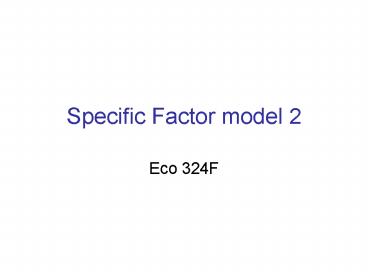Specific Factor model 2 PowerPoint PPT Presentation
1 / 17
Title: Specific Factor model 2
1
Specific Factor model 2
- Eco 324F
2
Welfare implications of trade
3
Structure
- Finish Specific Factor model
- Recap Returns to factors from liberalisation
- Changes in specific factor
- Changes in mobile factor
4
Recap Impact of 10 increase in PF/PC
- Change in relative prices assume 10 D in PFood
Pcars remains constant
MRPL cars
W
W
MRPL FOOD
W
W
0food
0cars
L
5
Returns to factors
- Preliminary Conclusions
- (1) Output of Food increased, Output of cars fell
- (2) Welfare impact on mobile factor labour is
ambiguous - (3) Land owners gained
- (4) Impact on owners of capital used in Car
production?
6
Returns to factors
- Owners of Capital
- D Pcar 0 but D wage gt 0
- Owners of capital (rK) are worse off
- Why?
- Under perfect competition constant returns to
scale - Price of a good is entirely allocated amongst the
factors of production PC G(w, rK) - Eg 0 D price a rise of wage (w) must be
offset by a fall rent (rK) - Here D W lt 10
- Therefore rK must fall
- The real return to capital in terms of both good
falls - (rK/ PFood) (rK/ Pcar) fall
Alternative explanation rK MPKPCar
MRPK Decline in LC raises K/L ratio, which lowers
MPK Hence rK falls
7
Returns to factors
- Conclusion
- Trade benefits the factor that is specific to
the export sector, but hurts the factor that is
specific to the import-competing sector. It has
an ambiguous effect on the mobile factor. - D rT gt D PFood gt D W gt D Pcar gt D rK
8
Change in Capital Stock
- Change in Capital stock FDI brings capital into
the country
9
Change in Capital Stock
- Change in Capital stock FDI brings capital into
the country
MRPL cars
W
W
MRPL FOOD
MRPL cars
W
W
W
0food
0cars
L
L
10
Returns to factors D capital
- Implications
- Output of cars increases (using capital as a
specific factor) - Output of food decreases as labour is drawn away
to car industry - Nominal wages rise in both sectors to W, which
is an increase in REAL wages as prices remained
constant - Real return to specific factors fall
- Price constant but Wage rises ? share of price
paid to specific factors (capital Land) must
fall
11
Returns to factors D capital
- Conclusion
- With prices remaining constant, an increase in
either specific factor reduces the return to both
specific factors while raising returns to the
mobile factor
12
SA Immigration Law COSATU
- The new policy is liked by unionists because of
stringent - critics say draconian - bureaucratic
requirements intended to protect South African
workers from alleged job insecurity feared from
an influx of immigrant workers.
13
Change in Mobile factor
Merely need to re-scale the horizontal access
representing Labour to account for new
immigrants. This is equivalent to a shift
rightwards of the Axis for Cars by the increase
in L. Alternatively, the Food axis can shift
leftwards
- Assume unskilled labour is mobile factor the
country experiences immigration of unskilled
labour. WHAT happens ?
MRPL cars
W
W
MRPL FOOD
W
W
W
W
0food
0cars
0cars
L
L
14
Returns to factors D labour
- Implications
- Output of cars and food increase (both using
labour as an input factor) - Nominal wages fall in both sectors to W, which
is a decrease in REAL wages as prices remained
constant - Real return to specific factors rise
- Prices constant but Wage fall ? share of price
paid to specific factors (capital Land) must
rise
15
Returns to factors D labour
- Conclusion
- With prices remaining constant, an increase in
the mobile factor reduces the return to the
mobile factor while raising returns to both the
specific factors
16
Specific factor model final conclusions
- Implications
- Tariff liberalization, foreign direct investment
and labour migration have real welfare impacts on
economic agents - Policy changes with respect to these factors can
give rise to substantial lobbying by vested
interest groups - Reform of an economic system becomes very
difficult to implement if there are specific
factors that are mobilized into lobby groups
17
Specific factor model final conclusions
- Policy proposals
- Bind liberalization programme through
international agreements such as bilateral or
multilateral reductions (WTO, Free trade
agreement with EU) - Reduce specificity of factors, i.e. training
programmes for labour, financial assistance for
new investment - Create mechanism in which winners compensate
losers

